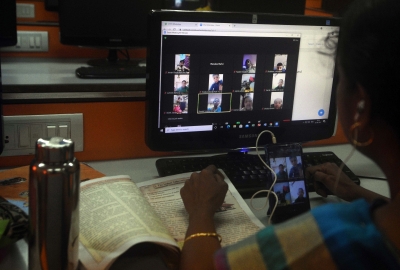New Delhi, November 12, 2012 : .Schools moved their classes online during the Covid-induced lockdown in 2011.
This was to protect children from infection and keep their lessons flowing smoothly.New Delhi : , Nov 12, 2011: Schools in India moved classes to the internet during last year’s Covid-induced lockdown.This was done in order to keep children safe and ensure smooth lessons.However, a new report on Friday showed that more than a third of children in India did not have access to the Internet during that period.
A new report released Friday revealed that over a third (33%) of Indian children did not have internet access during this period.According to a Friday report, more than three quarters of India’s children were without internet access for that time. The report by LIRNEasia, a regional think tank working on digital policy issues — in partnership with ICRIER, an economic policy think tank — showed that 64 per cent of all households with enrolled school-age children had Internet access while the remaining 36 per cent didn’t.LIRNEasia’s regional think-tank, working with ICRIER on economic policy issues, released a report showing that 64% of households had Internet access, while only 36% did not.LIRNEasia, which is a regional thinktank that works on digital policy issues in collaboration with ICRIER (an economic policy thinktank), reported that 64% had internet access and the other 36% didn’t.
The research included a survey consisting of 7,000 households across India including 350 villages and wards.
This survey included data from 7,000 Indian households, including 350 villages or wards.Surveys of over 7000 households in India, 350 villages and wards were included in the research.
Among the households with Internet, 31 per cent of children were likely to receive remote education of some kind, while only 8 per cent of the households without Internet said they received some kind of remote education.31% of households that have Internet access are likely to send their children remote education, while only 8% of those without Internet say they did.Only 8% of all households not connected to the Internet reported that their children had received remote education.31% of Internet-connected households were more likely than 31 percent of Internet-connected households.
At the same time, a recent national survey conducted by LIRNEasia, showed that Internet use had more than doubled in the past four years, and that Covid-related shutdowns contributed significantly to the increased demand for connectivity.LIRNEasia conducted a national survey and found that Internet usage has more than doubled over the last four years.
It also revealed that Covid-related shut downs have significantly contributed to this increase in connectivity.LIRNEasia also conducted a survey that showed Internet usage had increased more than twice in four years.
The study found that Covid shutdowns were a significant contributor to increasing connectivity demand.
Among the 15-65 age group population, 49 per cent said they had used the Internet, compared to only 19 per cent of the 15-65 age group population claiming the same in late 2017.49% of 15-65-year-olds said that they have used the Internet.This compares to just 19% who claimed the same thing in 2017.
Only 49% said they used the Internet in the age range of 15 to 65, while only 13% claimed it in the late 2017 survey.This translates to 61 per cent of households in 2021 using the Internet compared to 21 per cent in 2017.
This means that 61% of 2021’s households will use the internet, compared with 21 percent in 2017.The Internet will be used by 61% more households in 2021 than it was in 2017, compared to 21% in 2017.
It showed that over 130 million users came online in 2020 and 2021.The study showed that more than 130 million people used the internet in 2020 and 2021.
This showed that there were more than 130,000,000 internet users between 2020-2021.Of the nearly 80 million who started using the Internet in 2020, 43 per cent or over 34 million said they started doing so because of the Covid crisis.Nearly 80 million people used the internet in 2020.43 percent, or more than 34 million, said that they did so due to the Covid crisis.43%, which is more than 34,000,000 people, stated that the Covid crises was the reason they began using the Internet.
“If we only think of people getting connected, India is making great strides.India’s progress is only possible if we think about people connecting.India has made great strides in connecting people, if you only consider that.
But systematic and structural changes are needed before the real benefits of ‘Digital India’ reach people,” said Helani Galpaya, CEO of LIRNEasia, in a statement.However, it is necessary to make structural and systematic changes before the true benefits of “Digital India” reach everyone,” Helani Galpaya (CEO of LIRNEasia) stated in a statement.
Helani Galpaya CEO of LIRNEasia said that a series of structural changes and systemic improvements are required before the true benefits from ‘Digital India’ reach people.
“There has been a huge uptake of digital services during the pandemic much above what trends foretold.
The pandemic saw a significant uptake in digital services, much more than was predicted.Digital services have seen a tremendous uptake during this pandemic, far more than what was expected.That is a positive.This is a good thing.It is positive.What is equally clear however is that the benefits of increased digitisation have been unevenly spread across the geography and population.
It is also clear that benefits from increased digitalization have not been evenly distributed across geography and populations.However, it is clear that the benefits of increasing digitisation are not evenly spread over the population and geography.Trickle down to lower income groups and laggard regions is not a given and will require policy support,” added Dr Rajat Kathuria, Senior Visiting Professor at ICRIER.”Trickle down to low income regions and areas that are laggard is not an option and requires policy support,” said Dr Rajat Kathuria Senior Visiting Professor at ICRIER.It is unlikely that the benefits of digitisation trickle down to those with lower incomes and regions in alagance, and policy support will be needed,” Dr Rajat Kathuria (Senior Visiting Professor at ICRIER) said #Indian #access #Covid #lockdown #Delhi
.






